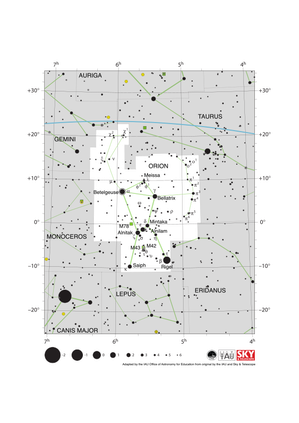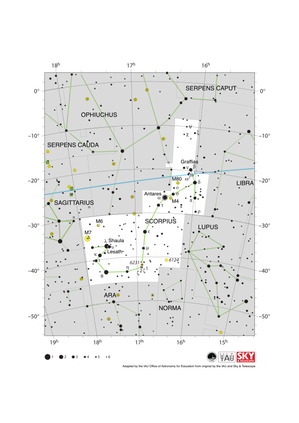Glossary term: Right Ascension (RA)
Description: Right ascension is one of two coordinates in the equatorial coordinate system (the other being declination), which astronomers use to define the positions of celestial objects in the sky. As seen from Earth, all the various positions in the sky together form what appears to be a distant sphere with Earth at its center. The points in the sky directly above Earth's equator form the celestial equator on that sphere. The point directly above Earth's geographic North Pole is the celestial North Pole, and that above Earth's South Pole, the celestial South Pole. Just like geographers define geographic longitude and latitude on Earth's surface, one can define longitude and latitude on the celestial sphere. If we were to choose a celestial object's longitude coordinate to be that of the location on Earth directly below, a star's coordinate value would change over time as the Earth turns. Instead, equatorial coordinates measure right ascension as a form of celestial longitude relative to a "meridian" in the sky that does not rotate with Earth, but instead is fixed relative to the fixed stars. That meridian, the analog of the Greenwich meridian on Earth, is defined by where it intersects the celestial equator: At the exact point where the Sun's apparent path crosses the celestial equator from the southern to the northern celestial hemisphere. This longitude is called right ascension. Its value increases towards the east. Look towards the celestial equator, and the longitude values will pass you by in the course of (roughly) 24 hours. That is why right ascension is typically stated as a time value, with 24 hours corresponding to the full 360 degrees. Declination, the second equatorial coordinate, corresponds to geographic latitude. A slight wobble in Earth's rotation axis known as precession makes the equatorial coordinate system, and with it the right ascension and declination of stars and other celestial objects, change over time, but only very slightly and very slowly.
Related Terms:
See this term in other languages
Term and definition status: This term and its definition have been approved by a research astronomer and a teacher
The OAE Multilingual Glossary is a project of the IAU Office of Astronomy for Education (OAE) in collaboration with the IAU Office of Astronomy Outreach (OAO). The terms and definitions were chosen, written and reviewed by a collective effort from the OAE, the OAE Centers and Nodes, the OAE National Astronomy Education Coordinators (NAECs) and other volunteers. You can find a full list of credits here. All glossary terms and their definitions are released under a Creative Commons CC BY-4.0 license and should be credited to "IAU OAE".
If you notice a factual error in this glossary definition then please get in touch.
Related Diagrams
Andromeda Constellation Map
Credit: Adapted by the IAU Office of Astronomy for Education from the original by IAU/Sky & Telescope
License: CC-BY-4.0 Creative Commons Attribution 4.0 International (CC BY 4.0) icons
Crux Constellation Map
Credit: Adapted by the IAU Office of Astronomy for Education from the original by IAU/Sky & Telescope.
License: CC-BY-4.0 Creative Commons Attribution 4.0 International (CC BY 4.0) icons
Orion Constellation Map
Credit: Adapted by the IAU Office of Astronomy for Education from the original by IAU/Sky & Telescope
License: CC-BY-4.0 Creative Commons Attribution 4.0 International (CC BY 4.0) icons
Libra Constellation Map
Credit: Adapted by the IAU Office of Astronomy for Education from the original by IAU/Sky & Telescope
License: CC-BY-4.0 Creative Commons Attribution 4.0 International (CC BY 4.0) icons
Scorpius Constellation Map
Credit: Adapted by the IAU Office of Astronomy for Education from the original by IAU/Sky & Telescope
License: CC-BY-4.0 Creative Commons Attribution 4.0 International (CC BY 4.0) icons













